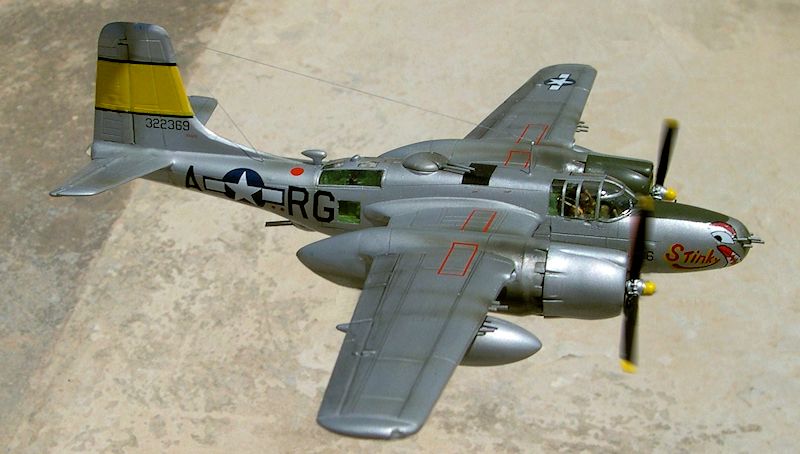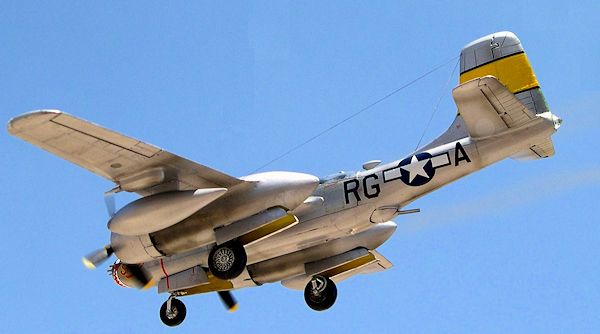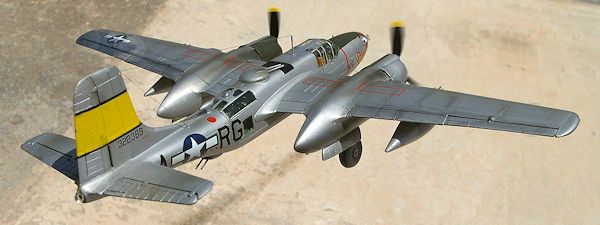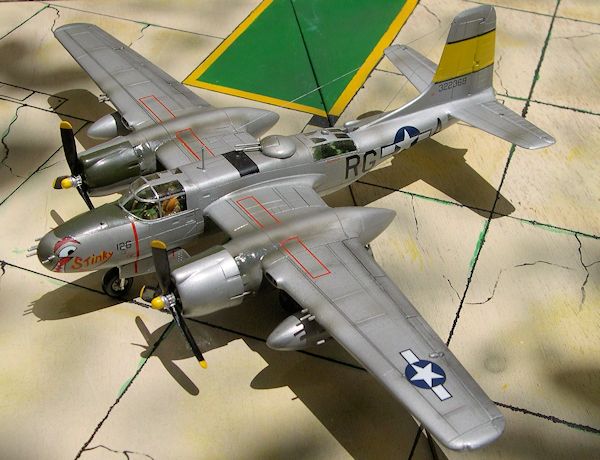
| KIT #: | ? |
| PRICE: | 18 Euros |
| DECALS: | Two options |
| REVIEWER: | Carmel J Attard |
| NOTES: |

| HISTORY |
The A-26 Invader was right from the start, so
good in the right hands that there was no sense in tempering with its
perfections. The plain fact is that
the A-26 fought in many wars than any other aircraft type. Americans flew it in
WWII, Korea, Vietnam; others flew it in Indo-China, Algeria, Biafra, Cuba and
Congo plus another dozen of other dirty little conflicts. Being a potent
light-bomber and remarkably durable the A-26 lasted beyond four decades.
 The A-26B with a solid gun-nose was designed
for ground attack role. It had six 0.5 machine guns in the nose which were later
on increased to eight, and remotely controlled dorsal and ventral turrets each
with two 0.5” guns and up to 10 more 0.5” guns in under wing and under-fuselage
packs. Heavily armoured and able to carry up to 4,000 lb bombs, the A-26B with a
maximum speed of 355 mph at 15,000 ft was the fastest allied bomber in WWII.
Some 1,355 A-26Bs were built which were followed by 1,091 A-26C, these having a
bomb-aimer’s glazed nose.
The A-26B with a solid gun-nose was designed
for ground attack role. It had six 0.5 machine guns in the nose which were later
on increased to eight, and remotely controlled dorsal and ventral turrets each
with two 0.5” guns and up to 10 more 0.5” guns in under wing and under-fuselage
packs. Heavily armoured and able to carry up to 4,000 lb bombs, the A-26B with a
maximum speed of 355 mph at 15,000 ft was the fastest allied bomber in WWII.
Some 1,355 A-26Bs were built which were followed by 1,091 A-26C, these having a
bomb-aimer’s glazed nose.
The A-26 was rushed into combat with 553rd
Bomb Squadron at Great Dunmow in England in September 1944 and soon it was
operating in France and Italy. It was flying air to ground missions against the
Germans and the pilots were delighted with its manoeuvrability and ease of
handling. Still not all the early days were rosy, it had a weak nose gear that
collapsed easily and an early cockpit canopy that was difficult to hold in the
‘open’ position for baling out. Time and attention resolved these problems and
A-26 pilots took pride in mastering a demanding but effective bombing machine.
In the European theatre the Invader flew
11,567 sorties and dropped 18,054 Tons of bombs. The A-26 was nimble enough to
hold its own when intercepted by fighters. Major Myron L Durkes of the 386th
Bomb Group at Beaumont in France was credited with the probable kill of an
Me-262 jet fighter on 19th February 1945. Some 67 Invaders were lost
to all causes but the A-26 also chalked up 7 confirmed air-to-air kills.
| THE KIT |
 Molded in silver plastic the A-26 was a very
welcome kit when it was released some years ago, having so many detail parts and
options that one could build from the kit. It had very clear cockpit and nose
transparencies. The fully detailed bomb bay was another feature that attracted
much attention and which could be completed with a full bomb load only seen
previously on the Marauder released earlier.
Molded in silver plastic the A-26 was a very
welcome kit when it was released some years ago, having so many detail parts and
options that one could build from the kit. It had very clear cockpit and nose
transparencies. The fully detailed bomb bay was another feature that attracted
much attention and which could be completed with a full bomb load only seen
previously on the Marauder released earlier.
| CONSTRUCTION |
Considering the time on the kit since its
release, no particular hitches were encountered during building of the model.
One alteration that I had to do to satisfy the version I decided to build was
the rearrangement of the 8-g un layout. I made reference to ‘A-26 in action’,
series of books and there I found the proper nose gun arrangement. I also
replaced the guns with hypodermic needles, which were cut to size and inserted
in place. One other extra work I did was sanding most of the surface rived
detail. Engraved panel lines at appropriate places replaced these.
un layout. I made reference to ‘A-26 in action’,
series of books and there I found the proper nose gun arrangement. I also
replaced the guns with hypodermic needles, which were cut to size and inserted
in place. One other extra work I did was sanding most of the surface rived
detail. Engraved panel lines at appropriate places replaced these.
This was practically a straightforward job
since the aircraft on the outside was an overall coat of silver mixed with a few
drops of gloss white. Interior was cockpit green and inside of engine cowlings
and wheel wells were painted in zinc chromate. I used Micro scale decal sheet No
72-281 that had an Invader A-26B in the markings of one that was nicknamed
‘Stinky’ of 386 BG at Beaumont-Sur-Oise, France on 20th April
1945. The aircraft was assigned to 552nd BS and carried codes RG-A.
Stinky was salvaged in Germany after the war ended. The Micro Scale decal
indicates the type to be overall light grey but pictures I have seen shows it
otherwise and hence it was metal finish. Wing walkways came from another Micro
Decal sheet.
| CONCLUSIONS |
This was my second Invader version I have
built recently. Another enjoyable build and I also found it to be a very
photogenic type of aircraft.
| REFERENCES |
 Ref: Airplane Encyclopaedia.
Ref: Airplane Encyclopaedia.
August 2013 If you would like your product reviewed fairly and fairly quickly, please
contact the editor or see other details in the
Note to
Contributors.